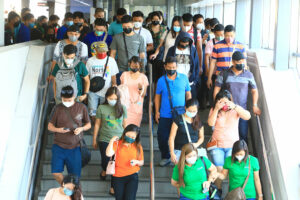‘Much better’ growth seen in 2nd half
THE PHILIPPINE ECONOMY is expected to perform “much better” in the second half of 2023, as the government ramps up spending, Finance Secretary Benjamin E. Diokno said. “The second half of growth will be faster than the first half. Because historically also, the fourth quarter is where most infrastructure projects are done,” he said in […]

THE PHILIPPINE ECONOMY is expected to perform “much better” in the second half of 2023, as the government ramps up spending, Finance Secretary Benjamin E. Diokno said.
“The second half of growth will be faster than the first half. Because historically also, the fourth quarter is where most infrastructure projects are done,” he said in a press briefing on Friday.
In the second quarter, the Philippine economy grew by 4.3% — its slowest growth in over two years, due to weaker household consumption and a contraction in government spending.
This brought first-half gross domestic product (GDP) to 5.3%, still below the government’s 6-7% target.
National Economic and Development Authority (NEDA) Secretary Arsenio M. Balisacan in a separate briefing on Friday said that attaining the 6% growth was still “very much doable.”
Economic managers earlier said Philippine GDP would need to expand by 6.6% in the second half to meet the lower end of the government target.
The Philippine Statistics Authority (PSA) is scheduled to release third-quarter GDP data on Nov. 9.
“To help improve economic growth, the Philippine government is expediting its public spending, particularly on infrastructure projects, by directing its agencies to put into action their catch-up plans. These plans aim to enhance budget execution efficiency for the remainder of the year,” the DoF said in a data sheet provided to journalists on Friday.
In the second quarter, government spending contracted by 7.1%, a reversal of the 6.2% growth in the first quarter and 10.9% a year ago, amid agencies’ low budget utilization.
As of end-August, the cash utilization rate of government agencies stood at 93%, behind the year-earlier pace of 95%.
Finance Undersecretary Zeno Ronald R. Abenoja said that with the implementation of these catch-up plans, government spending is projected to improve by the end of the year.
“Of course, there will still be a lot of uncertainty, but certainly the trajectory is a significant improvement from the performance as of the middle of this year,” he added.
Several departments presented their catch-up plans and estimated disbursement rates during the Economic Development Group (EDG) meeting on Oct. 4. These included the Department of Public Works and Highways (DPWH), Department of Transportation (DoTr), Department of Health, Department of Social and Welfare and Development, Department of Agriculture, and the National Irrigation Administration.
“The agencies that were requested to present are those with the biggest allocation of budget, but less than 40% utilization rate based on their latest available data for 2023,” the DoF said.
The DoF said the DPWH “appears to perform well with its catch-up plans and disbursement target that is three-fourths higher than its historical performance in the past five years,” but it was still asked to present since it plays a key role in public construction.
According to the agencies, challenges to efficient spending include seasonality in project implementation, procurement, implementation and payment issues.
“One issue, for example, involves procurement. The documentation requirements, how they define the terms of the procurement. So, a better design of the terms of the procurement will help ensure that the process will proceed as planned,” Mr. Abenoja said.
He noted that the government will be “close” to hitting its spending target this year.
“We think we’ll be close to what was initially planned. So, that’s the commitment that was provided by the different agencies,” he added.
Data from the Bureau of Treasury (BTr) showed that state expenditures as of end-August rose by 3.54% to P3.31 trillion. This accounted for 63% of the full-year spending program of P5.228 trillion.
According to the DoF, the government is ramping up infrastructure spending, reflecting efforts “to enhance the quality of spending in the midst of fiscal consolidation while remaining supportive of growth.”
Data from the Department of Budget and Management (DBM) showed that expenditures for infrastructure and other capital outlays rose by 44.1% to P111 billion in July from P77 billion in the same month a year ago.
Month on month, infrastructure spending was also up by 7.1% from the P119.4 billion in June.
“This was primarily credited to the larger capital expenditures of the DPWH for its various infrastructure projects nationwide,” the DBM said.
It also recorded “sizable” disbursements in railway projects of the DoTr, funding for the Department of Education’s computerization program, and the construction, repair, and rehabilitation of court buildings and offices of the Judiciary.
In the seven-month period, infrastructure spending increased by 12.9% to P618.2 billion from P547.5 billion in the same period in 2022.
The DBM said this was due to “progress billings and payments made for ongoing and completed infrastructure projects of the DPWH, as well as direct payments made by development partners for the foreign-assisted rail transport projects of the DoTr.”
The government is planning to spend 5-6% of GDP annually on infrastructure. This year, it targets to spend 5.3% of GDP on infrastructure, equivalent to P1.29 trillion. — Luisa Maria Jacinta C. Jocson













